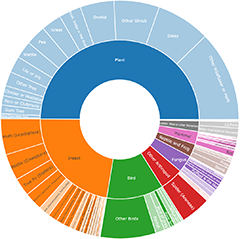Pored or somewhat maze-like on underside [bracket polypores]
In most species of this sub-group, the underside of the fruitbody has pores. In most cases the pores are small (two or more per millimetre) and of uniform size and appearance. However, in some species the pores are larger or of irregular shapes and sizes or incomplete and so giving a maze-like appearance. Sometimes you may see a mix of pored and maze-like regions in the one fruitbody.
In the following hints you see examples of useful identification features and a few of the more commonly seen genera in which at least some species (not necessarily all) show those features.
Hints
Red, fleshy texture: Fistulina.
Orange, leathery to corky texture: Piptoporus, Pycnoporus, Rigidoporus.
Pinkish to pinkish-brown, texture of firm rubber: Rhodofomitopsis.
Corky texture; creamy to yellow- brown: Perenniporia.
Upper surface furry & orange-brown to red-brown, pores white: Postia.
Large, creamy to pale brown, on live trees: Laetiporus.
On the wood of native or introduced conifers: Gloeophyllum.
Pores large, several millimetres in diameter: Hexagonia.
Underside maze-like or a mixture of pores & irregular gills: Cerrena, Gloeophyllum.
Hard & woody, black upper surface, pores brown to bronze: Phellinus.
Hard & woody, brown upper surface, pores white & marking brown: Ganoderma.
Hard & woody, brown upper surface, pores white & not marking brown: Fomes.
Roughly semi-circular, leathery, concentrically banded upper surface; white pores: Trametes.
Note: Trametes is a very common genus and is the one (with these features)
that you are most likely to see.
Announcements
There are currently no announcements.
Discussion
zz Polypore (shelf/hoof-like)
Rhodofomitopsis lilacinogilva complex
Top contributors
- Hejor1 123
- trevorpreston 90
- Teresa 56
- AlisonMilton 35
- ConBoekel 35
- Mike 35
- TimL 34
- JackyF 32
- KenT 25
- Csteele4 23
Top moderators
- Heino1 543
- Heinol 217
- Teresa 76
- Heino 68
- Pam 51
- MichaelMulvaney 50
- Csteele4 46
- JTran 38
- KenT 18
- CanberraFungiGroup 12















